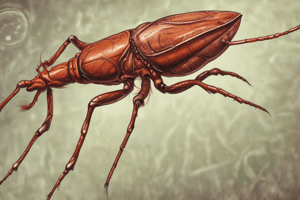Podcast
Questions and Answers
What is the primary method by which trypomastigotes enter a host during Chagas disease transmission?
What is the primary method by which trypomastigotes enter a host during Chagas disease transmission?
- Direct contact with infected body fluids
- Through mucosal membranes (correct)
- Ingestion of contaminated food
- Inhalation of infectious aerosols
Which of the following species is NOT considered a common triatomine vector for Chagas disease?
Which of the following species is NOT considered a common triatomine vector for Chagas disease?
- *Panstrongylus*
- *Cimex* (correct)
- *Triatoma*
- *Rhodnius*
What is a characteristic feature of the acute phase of Chagas disease?
What is a characteristic feature of the acute phase of Chagas disease?
- Only presents with gastrointestinal problems
- Frequently causes death
- Typically asymptomatic (correct)
- Always shows severe symptoms
What is the primary public health risk associated with body lice?
What is the primary public health risk associated with body lice?
Which group of mammals commonly serves as reservoirs for Chagas disease?
Which group of mammals commonly serves as reservoirs for Chagas disease?
What is the primary method through which Cimex lectularius infests humans?
What is the primary method through which Cimex lectularius infests humans?
What unique mating behavior is exhibited by bed bugs?
What unique mating behavior is exhibited by bed bugs?
Which species is primarily found in tropical and subtropical regions?
Which species is primarily found in tropical and subtropical regions?
What is the main concern arising from bed bug bites?
What is the main concern arising from bed bug bites?
How can Trypanosoma cruzi enter a host?
How can Trypanosoma cruzi enter a host?
Flashcards
Lice
Lice
A parasitic insect that lives on a host and feeds on their blood. There are different types, each with its own area of the body it prefers, such as head, body, or pubic hair.
Acute Chagas Disease
Acute Chagas Disease
The acute stage of Chagas disease, often with mild or no symptoms.
Triatomine Insect
Triatomine Insect
A type of blood-sucking insect that carries and transmits the parasite that causes Chagas disease. They are commonly called 'kissing bugs' because they often bite around the lips, but they are not kissing bugs in the conventional sense.
Trypanosoma cruzi
Trypanosoma cruzi
Signup and view all the flashcards
Chronic Chagas Disease
Chronic Chagas Disease
Signup and view all the flashcards
Bed bug species
Bed bug species
Signup and view all the flashcards
Bed bug life cycle
Bed bug life cycle
Signup and view all the flashcards
Bed bug medical impact
Bed bug medical impact
Signup and view all the flashcards
Chagas disease agent
Chagas disease agent
Signup and view all the flashcards
Chagas disease transmission
Chagas disease transmission
Signup and view all the flashcards
Study Notes
Life Cycle of Trypanosoma cruzi
- An infected triatomine insect vector ("kissing bug") takes a blood meal and releases trypomastigotes in its feces near the site of the bite.
- Trypomastigotes enter the host through the bite wound or intact mucosal membranes, such as the conjunctiva.
- Inside the host, the trypomastigotes invade cells near the site of inoculation, where they differentiate into intracellular amastigotes(1).
- The amastigotes multiply by binary fission(3) and differentiate into trypomastigotes, and then are released into the circulation as bloodstream trypomastigotes(4).
- Trypomastigotes infect cells from a variety of tissues and transform into intracellular amastigotes in new infection sites.
- The bloodstream trypomastigotes do not replicate, different from the African trypanosoma.
- When the parasites enter another host or are ingested by another vector.
- The kissing bug becomes infected by feeding on a human or animal.
- The ingested trypomastigotes transform into epimastigotes(5)
- epimastigotes multiply and differentiate in the midgut(7)
- trypomastigotes differentiate into the infective metacyclic trypomastigotes(8).
Chagas Disease
- Chagas disease has an asymptomatic phase and can present with an acute phase and a chronic phase.
- The acute phase is usually asymptomatic but can present with nonspecific somatic symptoms.
- Rarely, the acute phase may be more severe with potential cardiac or neurologic symptoms.
- Nodular lesions around the vector's feeding site.
- Chagas as palpable and peri ocular firm swelling, commonly referred to as occurring on the eyelids are common.
- Most acute cases resolve over a period of a few weeks or months.
- A subclinical chronic form of the disease.
Studying That Suits You
Use AI to generate personalized quizzes and flashcards to suit your learning preferences.




